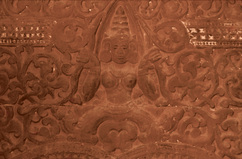Main Menu
AORC Libraries
Women in Sri Lankan Sculpture and Painting
Dublin Core
Title
Composite figures (part female) - Narilata
Subject
Symbolism in art (Narilata)
Wood-carving--Vakirigala temple,Kegalla--Sri Lanka
Decorative art
Description
This representation of the Narilata on the lintel of the wooden doorway of the Vakirigala temple in the Kegalle district, Sri Lanka, is extremely important for its symbolic meaning. Taking the place of the Laksmi motif, the Narilata seems to symbolize prosperity and good fortune. The carving seems to belong to the Kandyan period (1529-1815 A.D.).
Creator
Sirima Kiribamune
Source
Vakirigala Temple--Kegalle, Sri Lanka
Date
1529-1815 A.D.
Period of study: 1986-1987
Version: 01/12/2012
Contributor
Co-Author: Seneviratna, Harsha
Technical Officer: Wijesinghe, Lalith
Technical Assistant: Jayasundare, Subhashini
Photographer: Madanayake, I.S.
International Center for Ethnic Studies, Kandy, Sri Lanka
Norwegian Agency for Development Cooperation
American Institute for Sri Lankan Studies, Colombo
Rights
All rights reserved by International Center for Ethnic Studies, Sri Lanka.
Relation
Forms part of Photographic documentation of Women as depicted in early Sri Lankan sculpture and painting / Slide in present collection
Format
JPEG 2000
Language
eng
Type
image
Identifier
PDWESLSP.S.145
Coverage
ce
Collection
Citation
Sirima Kiribamune, "Composite figures (part female) - Narilata," online in Digital Library for International Research Archive, Item #12642, http://www.dlir.org/archive/items/show/12642 (accessed April 24, 2024).














